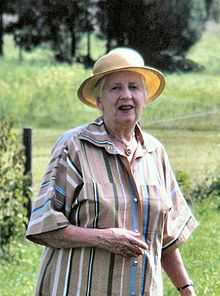Marie-Louise von Motesiczky

Marie-Louise von Motesiczky (October 24, 1906, – June 10, 1996) was an Austrian painter.
Life and work
She was born in Vienna in 1906 to an aristocratic family. Her father Edmund von Motesiczky was a talented cellist and keen huntsman. Her mother Henriette von Lieben, came from one of the most wealthy and cultured families in the Habsburg Empire. They had donated many of the art-works in the Kunsthistorisches Museum, and, in their palatial salon opposite the opera, Hugo von Hofmannsthal had read his first poems. Their own art-collection at the family's country estate in Hinterbruhl was formidable. After leaving school aged only 13, Marie attended art schools in various locations around Europe including Vienna, Paris (at the Montparnasse Painting Academy) and Berlin. In 1928, Max Beckmann invited her to join his masterclass at the Städelschule in Frankfurt am Main, where she honed her craft and the two became lifelong friends. Motesiczky spent the next 10 years developing her craft but, as her family included Jewish descent, she had to flee the Nazi annexation of Vienna in 1938.
Motesiczky, accompanied by her mother Henriette, fled to London via Amsterdam where she joined the Artists' International Association and contributed to some of their exhibitions; her first solo exhibition followed in London in 1944. Her brother, who stayed behind, was killed by the Nazis for opposing the regime. During this period she also became romantically involved with the writer Elias Canetti, who was to remain a close companion and friend for many years to come. The second great influence on her work after Max Beckmann was Oskar Kokoschka. Her large circle of friends also included the sculptor Marie Duras, the art historian Sir Ernst Gombrich and the artist Milein Cosmann.
Following the end of the war, Motesiczky exhibited her paintings in many European institutions and she continued to work from her house in London, where she lived only with her mother and a single maid. She had grown to love London. Her mother became the subject of many of her paintings after 1960, with Motesiczky chronicling her encroaching frailty in paintings such as The Old Song and From Night into Day. Motesiczky also painted many figurative ‘fantasy paintings’, dream-like paintings which blurred fantasy and reality but which alluded to her own experience and were loaded with personal symbolism.
Motesiczky's major breakthrough in the UK occurred in 1985, with a major retrospective at the Goethe Institute in London, which generated much acclaim and saw her reputation as a major Austrian artist cemented. However, on the subject of exhibiting, as The Independent wrote, "Motesiczky never needed to sell her paintings, indeed she preferred to keep them around her. An aristocratic disdain for the marketplace meant that, while she half welcomed exhibitions, they remained uncomfortable experiences."[1] Apart from several works in well-known public collections, including the Scottish National Gallery of Modern Art, Stedelijk Museum of Modern Art, the Tate Gallery, the National Portrait Gallery (London), the Fitzwilliam Museum, the Österreichische Galerie im Belvedere and numerous private collections, she kept the main body of her work in her own house. She died in London in 1996. Her paintings, drawings and personal papers passed into the possession of the Marie-Louise von Motesiczky Charitable Trust under the founding Chairmanship of Jeremy Adler which has devoted itself to preserving, cataloguing, and promoting her work.
Of her life in art, she once remarked “If you could only paint a single good picture in your lifetime, your life would be worthwhile.”
Diana Athill wrote about her friendship with Motesiczky in her autobiography 'Somewhere Towards the End' (Granta, 2008).
References
- ↑ Obituary: Marie-Louise von Motesiczky Saturday, 15 June 1996, Peter Black